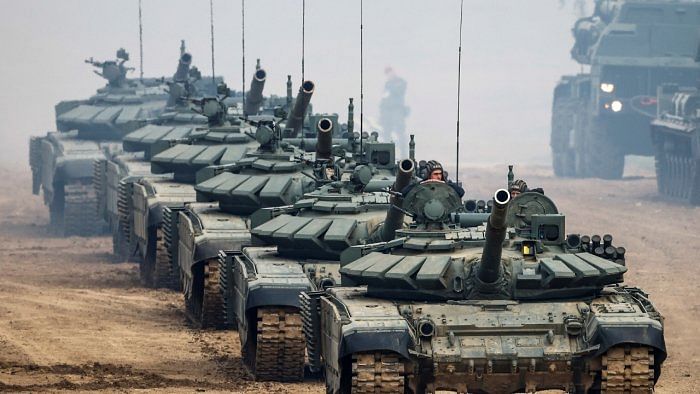

It has been 506 days since Russia launched its “Special Military Operation” to "demilitarise and denazify” Ukraine. Russia controlled about 25 per cent of Ukrainian territory at the peak of the invasion. It has now diminished to roughly 16 per cent after successful counterattacks by the Ukrainian forces. Presently, the frontlines bring back the memory of the haunting visage of World War I trench warfare, where success was measured in yards and exacted at a frightful human cost.
This is Europe's first full-scale conventional conflict since 1945, featuring two large militaries armed with sophisticated weapons. It is, therefore, being keenly observed by strategic experts around the world. The war offers a wealth of lessons in geopolitical and strategic matters, but I will limit my discussion to evaluating some significant lessons on the conduct of military operations. These are relevant to the Indian military as it embarks on a series of reforms to restructure and modernise its forces.
The paramount lesson we must grasp is the undeniable truth: wars are essentially a contest of will. A nation’s will extends beyond mere military capability to encompass the fortitude of national leadership and the tenacity of the population. Pursuing a swift victory predicated on a superficial comparison of military forces can prove calamitous, as Russia has found.
The Indian military has traditionally based its planning on fighting short and swift wars. The “Joint Doctrine of the Armed Forces-2017” characterised future wars as “ambiguous, uncertain, short, swift, lethal”. This thinking is now changing, with the army chief, General Manoj Pande, stating in March this year: “The assumption of a short and swift war may prove to be flawed, and we need to be prepared for a full-spectrum conflict, for even a prolonged duration.”
Preparing for a protracted conflict will require not only a doctrinal shift but also the material build-up of war reserves. We have seen how countries like the United States, with a highly developed military-industrial base, are struggling to supply adequate ammunition to Ukraine. Therefore, it is crucial that plans for stocking levels and boosting wartime production be drafted immediately.
Information warfare
Information warfare is playing a critical role in the battle of the narratives. Both sides have resorted to disinformation and propaganda to influence domestic and international audiences. The state agencies, national broadcasters, grey-zone actors, volunteers and social media influencers have all been roped into the information campaign.
Social media has been weaponised to disseminate false information, like deepfakes depicting President Vladimir Putin declaring peace in the war and President Volodymyr Zelenskyy surrendering to Russia. The Ukrainians strive to demoralise Russians and prompt soldiers to surrender by frequently releasing Russian death tolls. They also use facial recognition on casualties to identify their social media profiles and send distressing images of corpses to their families.
While information warfare is a national effort, the Indian military should take the lead in crafting a strategy for its wartime implementation. This strategy must aim to minimise foreign software and hardware dependencies in our critical information infrastructure. The Ukraine war has shown that technology companies have taken clear national sides in the information campaign.
While much of the reporting on the war has been on the human cost, attrition-style warfare, and massive artillery barrages, technology has played a ubiquitous role. The Ukrainian military uses the Delta app, which integrates information from sensors on the battlefield, American commercial satellites, social media posts, and human sources to enhance situational awareness. The Starlink terminals supplied by Elon Musk’s SpaceX company ensure this information is passed down to the lowest level. The Artificial Intelligence tools provided by the American company Palantir are used to identify high-value targets that are struck by smart munitions or drones.
Drone warfare
Drone warfare is being waged at an unprecedented level, most of it with affordable, commercial systems. According to a report published in May by the Royal United Services Institute, Ukraine is losing approximately 10,000 drones every month on the battlefield. This figure is indicative of the scale at which drones are being used for a range of activities – surveillance, destroying targets from the forward trenches up to Kyiv and Kremlin, and even drone-on-drone conflict.
One lesson that has emerged from the war is that possessing technology is only part of the solution. Effective use of technologies is determined to a large extent by the operational concepts for their employment. Here, the Ukraine military has shown great skill in using technology in innovative ways to achieve tactical successes.
As the Indian military increasingly adopts new technologies, it must also create appropriate organisational structures and develop strategies on how technology will be employed on the battlefield. The existing cyber, space, electronic warfare, and information warfare functions must be combined under a single joint command to achieve greater synergy and effectiveness. Greater interaction with the industry is essential to see how dual-use technologies can be utilised.
The Ukraine war underlines the paramount importance of land power. Air and naval power are decisive elements for any military victory, but success is ultimately measured by gains or losses of territory. Kyiv's primary war aim is to restore the territorial integrity of Ukraine, while Moscow’s goals are to hold on to the captured southern regions of Ukraine and the Donbas region.
India has unsettled land borders with Pakistan and China, and it is primarily here that victory or defeat will be decided. The three services must sit together to define the military objectives essential for victory clearly. After that, an integrated plan can be drawn up on combining the various elements of military power to achieve the objectives.
Finally, the war also underscores that military effectiveness is largely determined by morale, fighting spirit, and unit cohesion. Ukraine's ability to resist a more powerful adversary is in part due to higher morale and motivation among its soldiers as compared to the Russians. Fortunately, the Indian military is a highly professional force, and efforts must be made to ensure that it remains so.
While not exhaustive, these lessons from the Ukraine war could provide valuable insights relevant to India's ongoing efforts to reform its armed forces.
(The writer is the former commander of the Indian Army’s Northern Command. He is currently a senior fellow at the Delhi Policy Group.)